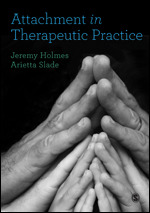Attachment in Therapeutic Practice
- Jeremy Holmes - Exeter University, UK
- Arietta Slade - Yale Child Study Center
This is a concise, accessible introduction to the basic principles of attachment theory, and their application to therapeutic practice. Bringing together 70 years’ of theory and research, its expert authors provide a much-needed user-friendly guide to attachment-informed psychotherapy.
The book covers:
- The history, research base, and key figures and concepts of attachment theory
- The key concepts of attachment theory, and their implications for practice
- Neuroscience implications of attachment and its therapeutic relevance
- The parallels and differences between parent-child attachment and the therapeutic relationship
- The application of attachment in adult individual psychotherapy across a number of settings, also to couples and families
- The applications of attachment to working with complex disorders
- The applications of attachment in child psychotherapy
Two extraordinary clinicians with decades of research and writing on attachment worked with immense application and skill to distill what is essential in attachment theory and brought it to psychotherapeutic practice. The result is an exceptionally comprehensive and profound work of lasting value for every clinician – regardless of orientation. The book is a guide to improving the practice of the most experienced therapists at the same time as offering the friendliest and most accessible of introduction to this complex field. It is a remarkable achievement from two of the most sophisticated and respected authors on the clinical application of attachment theory. It provides a vivid picture of the process of bonding and lifelong transformation which attachment theory inspired therapy can bring. The book is for everyone who is serious about working psychotherapeutically and will not be bettered as an introduction for many many years to come
Holmes and Slade have provided exactly what the mental health professions have needed—a comprehensive examination of how attachment theory informs psychotherapy that is entirely accessible to beginner therapists, but also highly informative to seasoned clinicians. This superb text deserves a place on the shelves of every psychotherapist.
This book is a ticket to journey along with Jeremy Holmes and Arietta Slade as they describe their sophisticated and creative views on attachment theory, research and the co-created space of the therapist-patient relationship. With the addition of evocative and varied clinical vignettes it's as if one is being personally invited into the consulting rooms of these two gifted clinicians to hear how they use an attachment perspective to inform their work. This book is indispensable to both the clinical apprentice and the seasoned practitioner.
The authors tell us ‘Despite exuberance of theory, once in the consulting room, psychotherapy is a practice in search of a theory.’ But we have theory! (I for instance studied first cognitive-behavioural, then systemic, then psychoanalytic theory; all are useful, what more do you want?) Also, as an attachment researcher and writer, I thought I would know the field. But this book draws together the history and cutting edges of attachment in ways that give really fresh angles on clinical experience. Learning attachment interviewing and coding, 25 years ago, added a powerful layer to my listening to patients (and to myself on the couch). Reading this book I am again shown that attachment theory and findings illuminate every other kind of clinical theory we use, and everyday life for good measure.
This is a very helpful mini-handbook for students as well as practitioners of attachment-based relational psychotherapy. It is written with many vignettes to explain concepts.
A very useful book for all trainees and practitioners wanting to understand how the basic principles of attachment theory inform clinical practice.
The book is concise yet comprehensive, highlighting key important concepts of attachment theory and how it influences the therapeutic encounter. This is demonstrated with clinical vignettes, where the authors highlight important aspects of attachment theory and illustrate how attachment informs clinical work.
Excellent introduction to use of attachment in practice.
This book has been added to the recommended reading list for my learners. It is very informative on all areas of attachment in the counselling field.Giving case studies and vignettes to spark thoughts on what to do and how to recognise various forms of attachment.
Quite difficult to find books which make clear in a relatively simple way the clinical applications of the attachment theory. This book does it !
A thoughtfully written text of great interest to students and professionals studying attachment theory and its application to practice. Accessibly presented with frequent and timely use of vignettes and case studies which really aid application and understanding of behaviours to practice experiences.








